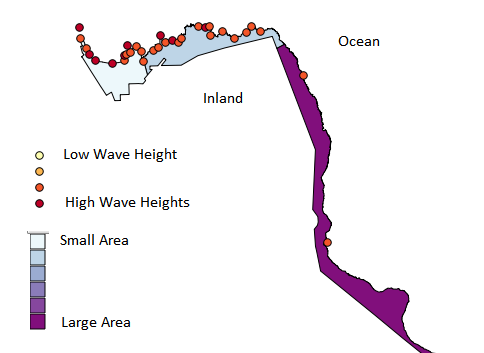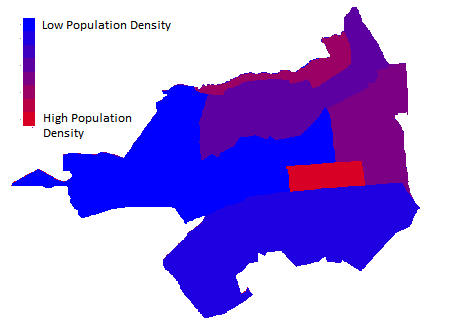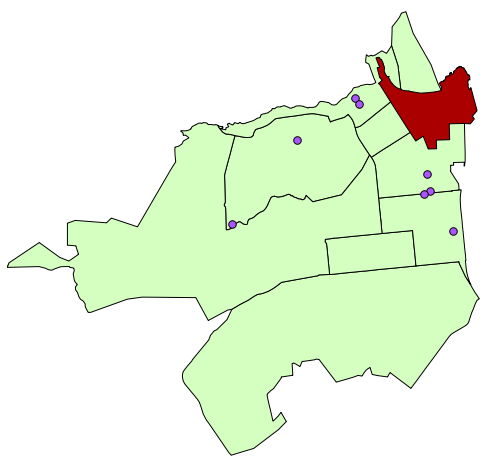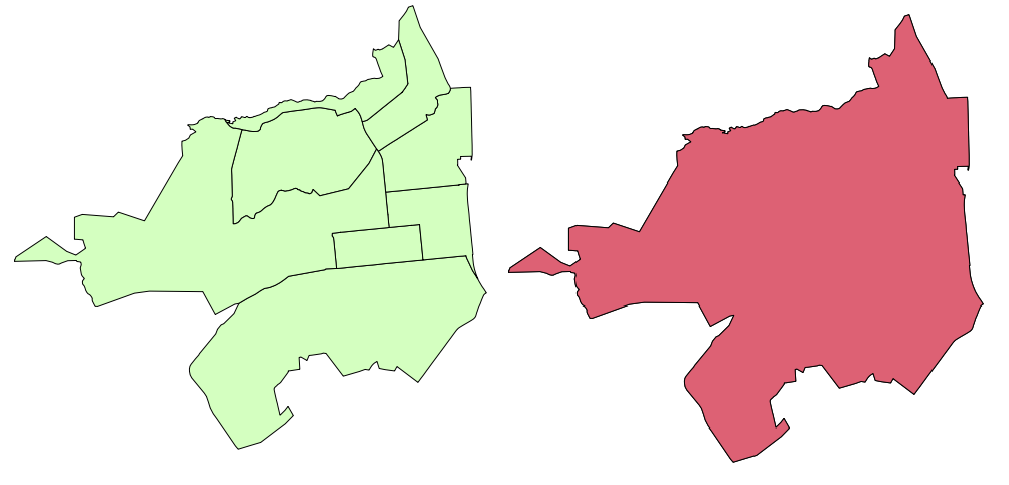Difference between revisions of "Emergency Shelter Allocation Evaluation"
Katiefeltz (talk | contribs) |
Katiefeltz (talk | contribs) |
||
| Line 187: | Line 187: | ||
==Methods== |
==Methods== |
||
| + | This section will enlighten you as to the process I took in creating a decision analysis. The creation of a suitability map is necessary to come to some sort of decision as to where the allocation of the funds is most appropriate. The process will be outlined step by step as done so thus far. While going through these processes with your own data it is important to keep the logic of what is ideal in your head, and what acceptable thresholds are in your head. |
||
| − | In this section, I will provide a step by step process of how I analyzed the layers that have been prepared for manipulation. |
||
| + | |||
| + | This projects interest is to find areas that are in the most need of emergency shelter expansion. Basically trying to locate the are of an emergency preparedness deficiency in terms of emergency shelters. Ultimate suitability for this location consists of the area with a high population density, far away from existing emergency shelters as possible, and far away from the evacuation land. |
||
| + | |||
| + | To explain this further, it is ideal to declare the highest population density as the most necessary requirement for this criteria because shelter capacity is not going to go as far, and more shelters will be necessary. It is ideal to be as far away from existing emergency shelters as possible as this will show the largest gap in coverage. Distance away from evacuation land is necessary because this is considered a high risk zone, and although that population will flood into the inland population's emergency shelters, this also causes for a distance away from this high risk zone. |
||
| + | |||
| + | As a reminder this analysis is using: |
||
| + | * Emergency Shelters - GRASS vector point file |
||
| + | * Evacuation Land - GRASS vector polygon file |
||
| + | * Census Tracts - GRASS raster file |
||
===Proximity Tool=== |
===Proximity Tool=== |
||
Revision as of 09:33, 16 December 2012
Contents
Introduction
 FACT: Hawaii is the State most at risk of Tsunami conditions, Getting about one per year, a highly damaging one every 7 years. The biggest tsunami that occurred in Hawaii happened in 1946 when the coast of Hilo was hit with 30 ft waves at 500 mph, 170 fatalities. Click here for more facts of Tsunami Danger.
FACT: Hawaii is the State most at risk of Tsunami conditions, Getting about one per year, a highly damaging one every 7 years. The biggest tsunami that occurred in Hawaii happened in 1946 when the coast of Hilo was hit with 30 ft waves at 500 mph, 170 fatalities. Click here for more facts of Tsunami Danger.
This project demonstrates how to make a spatial decision that determines the best use of monetary resources when further developing the emergency preparedness framework of a community. Spatial allocation decisions often can not be made most efficiently with consideration of only an independent variable, and scenarios realistically exist as multi-criteria based. This tutorial will demonstrate how this evaluation can be carried out using only Free and Open-Source Software(FOSS), particularly using the Quantum GIS (1.8.0) package and the GRASS Plugin.
Particularly, the scenario that outlines what the objectives are for this tutorial involve the expansion of Emergency Shelters in Hawaii pertaining to the emergency of a Tsunami event. The funding for this expansion has specific criteria which is as follows:
- Funds must be concentrated to the area of highest risk to large waves within the State.
- Shelter Location must be far away from Evacuation Land.
- Shelter Location must be in area of highest population density.
- Shelter Location must be far away from existing Shelters.
This tutorial is directed towards someone who has a minimal or basic understanding of GIS. The processes outlined throughout this tutorial may also be applicable in understanding gaps of public safety as a community evolves, or something as simple as determining the best location for a business expansion. The variety of applications are extremely widespread.
Data Collection
For this specific scenario, it was necessary to collect a variety of shapefiles (vector data) that are freely available online. There is a variety of online databases that have appropriate files with access to download freely. Sources of data very much depend on your geographical location and the government availability of free files.In this particular case the data was gathered from a catalog provided by the Hawaii State Government and U.S Census Bureau. Table 1. provides a specific breakdown of where each file was found and the adequacy of it.
| Shapefile Name | Format | Data Source | Description |
|---|---|---|---|
| Tsunami Evacuation Zones | Vector Polygon - Preliminary Analysis/Final Anaysis File | Hawaii State Office of Planning | High risk area to Tsunami impact. |
| Tsunami Wave Heights | Vector Point - Preliminary Analysis File | Hawaii State Office of Planning | Locations of large wave events along the coast, attributes include year by year breakdown of events. |
| Emergency Shelters | Vector Points | Hawaii State Office of Planning | Locations of Shelters, and individual capacity. |
| Census Tracts | Vector Polygon | U.S Census Bureau | Total Population by tract, 2009 TIGER/Line Shapefiles for: Hawaii |
Setup
As mentioned within the introduction Quantum GIS(QGIS) version 1.8.0 is used to carry out this analysis, and within this platform the GRASS Plugin is also used in combination with QGIS tools. The following three sections will provide specific instructions as to how to download the necessary software and the appropriate set up to begin your project.
Install QGIS
If you don't already have the appropriate software downloaded to your computer, Click here to do so according to your running platform of your computer. I used Windows 1.1 Standalone Installer, and had no problems. Along with this download is the GRASS package that will allow you to add the GRASS plugin once you are in QGIS, requiring no additional download for this plugin.
Install GRASS Plugin
From this point forward through the tutorial it is assumed you have QGIS open. Having the GRASS plugin installed within your project allows for access to a wide variety of additional tools that are extremely useful, as you will see throughout this tutorial. The following steps will direct you to successfully loading the GRASS plugin.
- Click Plugins tab ⇒ Click Manage Plugins ⇒ This will open up QGIS Plugin Manager Window
- In filter type GRASS, and ensure there is an X in the box ⇒ click OK.
- Click Plugins tab ⇒ GRASS tab will now appear ⇒ Expand the list of tools ⇒ Click 'New Mapset'
- Click Browse to find destination folder NOTE: you must have a destination folder already in Windows Explorer ⇒ Click Next,
- Create new location (Named mine Project) ⇒ Click Next.
- Define your projection. This can be found within the metadata of your shapefiles, or on the site from which you downloaded the data ⇒ Click Next.
- Define GRASS region ⇒ I selected USA, as it seemed most appropriate ⇒ Click Next.
- Name your mapset (Named mine Hawaii)⇒ Click Next.
- Click Finish, mapset has now been created.
- Go to the Plugins tab ⇒ Click GRASS ⇒ Click Open Mapset ⇒ Select what you have just created and now your work will be within this mapset.
Setup Workspace
Before starting anything further it is important to save your workspace.
- Click File tab ⇒ Click 'Save Project As' ⇒ save it alongside your other data.
- Continue to save workspace ongoing.
Then you can load your shapefiles into your workspace (Only Vectors to work with):
- Click the 'Add Vectors' button at the top left of the screen.
- Leave the 'Source Type' as File, and Encoding as System (default).
- Browse to location you saved your data and click a file (Press Ctrl on keyboard to select many at once)⇒ Click Open ⇒ Your data will now be visible and the layers are a part of the table of contents on the left hand side of the window.
Preliminary Analysis
Initially it is necessary in this particular instance to perform a preliminary analysis. This will narrow down exactly what region of Hawaii is most vulnerable to Tsunami activity.
Deciding Area of Interest
The shapefiles used for this process were Tsunami wave event recording points and Evacuation Land polygons, outlined in Table.1. The area of interest was determined based on the quantitative attributes within each file. The following section will outline the process of creating an output that would assist in deciding what the most vulnerable area is, resulting in our specific area of interest.
Quantitative Map Output
Exploring the attributes is majorly helpful in deciding how to manage the data available. That is the first step I took. To view the attributes please follow these outlined steps:
- After adding your data to the table of contents, you will now be able to view all necessary layers.
- Right click the title of your layer (file name) which will open a menu ⇒ click 'Open Attribute Table'
- Here you will be able to view the columns of data.
I chose the Wave Heights layer to explore first. It had a column for each significant year of high waves, showing the highest recording of that year for each storm location. I then thought it would be appropriate to quantify these values spatially. To do so it was necessary to edit the attribute table, and add an additional column to calculate the total significant recordings. The following steps outline how I processed this information:
- Within the Attribute table window Click the 'Toggle Editing Mode' button
 ⇒ Click 'Add Column' button
⇒ Click 'Add Column' button 
- Type in an appropriate name, and keep the Type as Whole Number ⇒ click OK.
- Click the 'Open Field Calculator' button
 ⇒ Make sure X is in box beside update existing field.
⇒ Make sure X is in box beside update existing field. - Select Field to edit in drop down menu ⇒ selecting field just created. NOTE: There is an option to the left of the calculator to add field at the same time as calculating data, but I have broken this down into separate steps.
- Create an expression. The expression used here is very simple. I selected fields that had wave height information in them and added them together to create a total.

The resulting column looked like this:
- Click the 'Save Edits' button within the Attribute table window.
- Toggle off the 'Toggle Editing Mode' button
 ⇒ Close the attribute table window.
⇒ Close the attribute table window.
Secondly, I explored the Evacuation Land shapefile attributes. It's attributes were much more simple and already had a column signifying the AREA of each parcel of Evacuation Land. The parcel with the largest area was determined as most significant. This brings us to the cartographic symbology process. This is relatively easy, the following outlining the specific steps.
Symbolizing the Evacuation Land layer:
- Right click the layer name ⇒ Click 'Properties'
- Click the 'Style' tab ⇒ where it says single symbol click the drop down menu and select 'Graduated'.
- Select column to symbolize, in this case it was AREA ⇒ choose a colour ramp, decide the number of classes appropriate (in this case 6), and type of classification (in this case equal interval).
- Click 'Classify' at the bottom left of the window ⇒ then 'Apply' and 'OK'
You should now see the layer symbolized, and the legend can be seen by expanding the layer in the table of contents.
Symbolizing the Tsunami Wave Height Event layer:
- Right click the layer name ⇒ Click 'Properties'
- Click the 'Style' tab ⇒ where it says single symbol click the drop down menu and select 'Graduated'.
- Select column to symbolize, in this case it was WaveHeightTotal ⇒ choose a colour ramp, decide the number of classes appropriate (in this case 4), and type of classification (in this case equal interval).
- Click 'Classify' at the bottom left of the window ⇒ then 'Apply' and 'OK'
You should now see the layer symbolized, and the legend can be seen by expanding the layer in the table of contents.
The following image shows the most vulnerable coastline area in Hawaii (by a very long shot). Assume the NW side of the area to be ocean, and the SE side to be the inland. 
This map quantitatively shows the information edited earlier. However, the polygons of the Evacuation Land is somewhat determined based on the population of that area (county/metropolitan area) rather than based on a terrain analysis, which could be considered an inconsistency and tough to base an accurate decision off of it independently. This brings in the importance of the Wave Height Total layer. It shows a remarkable number of incidents, all of which are the highest or second highest events in the state. Therefore, this area of Hilo City was determined as the area of interest for this project, despite some inconsistencies within the data. For the sake of this being a precautionary preliminary step this is a pretty good method of narrowing down a area of interest (AOI). Further analysis could be done by finding the historical records of the state, and statistically analyzing the information and create your own vector layer accordingly.
Data Processing
This section involves preliminary editing that narrows the data collected for the entire state down to just the AOI of Hilo. These stages will bring simplicity to the later stages of this project, and have all the files in the exact formats necessary to carry out this analysis.
Please note: altering the projection was not necessary in this project, and therefore not included in this tutorial. If this is the situation for your data please click here for methods of changing projection.
Clipping to AOI
Clipping is the process of creating a new vector file that include only the data required for the very specific area of interest. The input features are extracted and made into an individual vector file. In this case Emergency Shelters, Evacuation Land and the Census Tracts data is needed to be clipped (Wave Heights not useful beyond preliminary analysis). The following will outline the steps necessary to complete a Clip.
- Select the 'Select by single feature' icon, and this will now allow your mouse to select the features that are included in your study area. You can also use 'Select by Rectangle', but often the irregularity of study areas causes for sections to be selected that aren't necessarily applicable. You can also select through the attribute table, there are many ways about going to do this.
- Once you have all the data within AOI selected ⇒ Click 'Vector' tab at the top of the QGIS window ⇒ Click 'Geoprocessing Tools' ⇒ Click 'Clip'
- Choose your input vector layer to be clipped ⇒ Ensure there is an X in the box that says 'Use only selected features'.
- Use Census Tracts Data to be the clip layer (extends beyond all other necessary data in this case) ⇒ Ensure there is an X in the box that says 'Use only selected features'.
- Name an output name in the appropriate directory by clicking 'browse' ⇒ Click 'OK'
- Repeat the last three steps again for all vectors that need to be clipped, in this case this was done for Emergency Shelters (output named ES.shp) and Evacuation Land (output named EL.shp)
After Clipping was complete, my data looked like this:
Dissolve AOI
This stage of data processing is necessary because after using the proximity tool within the methods section, the created output from this step will be used as a mask to clip that raster file to this extent. Dissolving simply means taking a vector file with multiparts (in this case multiple polygons) and making it one uniform polygon. In this project, a dissolve was performed on the Census Tract polygon vector file. The following steps outlines how this was done.
- Once you have all the data within AOI selected ⇒ Click 'Vector' tab at the top of the QGIS window ⇒ Click 'Geoprocessing Tools' ⇒ Click 'Dissolve'
- Input Census Tracts layer ⇒ dissolve the AREA field ⇒ name an output file and place it in appropriate directory ⇒ Click 'OK'
The above image shows the before and after of the dissolve tool.
Attribute table editing
To turn on the capability of editing your attributes please follow these steps:
- Right click the title of your layer (file name)in the table of contents which will open a menu ⇒ click 'Open Attribute Table' ⇒ Here you will be able to view the columns of data.
- Within the Attribute table window Click the 'Toggle Editing Mode' button

Calculating Population Density
Population density was calculated for the Census Tracts layer. The census tracts are not even in size, and so therefore it is not mathematically correct to symbolize only the total population but the population based on the area of the polygon to create normalization. I had to refer to the metadata that was downloaded in conjunction with the shapefile to figure out what column represented the total population, as a large number of columns of information are available in this layer's attributes. In this case total population was represented by column DP0010001. The other column of information that is useful throughout this calculation is the Area variable column, which is very common to have included, although it may also be necessary to calculate initially (calculate geometry). The following steps outline how the population density was calculated (assuming you have toggled the editor on):
- Click 'Field Calculator' button
 ⇒ Leave X in box beside 'Create a new field' ⇒ Type a Field name (in this case POPdensity) ⇒ Leave output field type and field width as default.
⇒ Leave X in box beside 'Create a new field' ⇒ Type a Field name (in this case POPdensity) ⇒ Leave output field type and field width as default. - Create your expression. In this case it was "DP0010001" / "Shape_Area" ⇒ Click 'OK'
- Toggle off the editing icon, once your calculations are complete.
You will now have a new column and it will be filled with the appropriate ratio calculated.
Data Conversion
While using this software it is important to understand the differences in file format. Shapefiles are an ESRI file type which is often the format available for free download, and GRASS has another file formats as well. Shapefiles will not be accepted as input when using the the GRASS plugin, but will be accepted within QGIS using some of the basic tools. This section will outline the necessary conversion processes to ensure there is not halt in progress within the analysis of your project.
ESRI Shapefile to GRASS Vector
- At the top of QGIS main window click Plugins Tab ⇒ Click GRASS ⇒ Click Open GRASS Tools.
- Click the Modules List Tab ⇒ and in the Filter Box type v.in.ogr.qgis ⇒ Click tool that says 'Import loaded vector' NOTE shapefile must be in table of contents at this time.
- Select a layer to load in for conversion to GRASS format.
- Give the Output Vector Map a name ⇒ Click 'Run' ⇒ Click View Output and the layer will appear in the TOC.
Repeat this process for all vector layers you plan to use. Although it wasn't ultimately necessary to do this when using only QGIS tools for 2 out of 3 layers used within my analysis it is nice to know you won't later run into issues where conversion is all of sudden necessary, so this can be done as a precaution. NOTE you will not see a visual difference between the shapefile and vector it is simply a file formatting situation.
GRASS Vector to GRASS Raster with Attributes
This step was carried out particularly on the Census Tract Population Density layer. The reason for converting with attributes is because it allows for keeping the Population density variable created, and have it spatially quantified. The following outlines how this was done:
- At the top of QGIS main window click Plugins Tab ⇒ Click GRASS ⇒ Click Open GRASS Tools.
- Click the Modules List Tab ⇒ and in the Filter Box type v.to.rast.attr ⇒ Click tool that says 'Convert vector to raster using attribute values'
- Select input vector layer you wish to rasterize (in this case the Census Tracts layer) in the drop down menu NOTE: layer must be turned on in Table of Contents in order to use GRASS tools using that layer as input.
- In the Attribute Field, select the Population Density column that was created ⇒ Give the Output Raster Map a name ⇒ Click 'Run' and once successfully complete ⇒ Click 'View Output'
This concludes the data processing necessary for this project. The following is the Census Tracts Population Density map in raster format.

Methods
This section will enlighten you as to the process I took in creating a decision analysis. The creation of a suitability map is necessary to come to some sort of decision as to where the allocation of the funds is most appropriate. The process will be outlined step by step as done so thus far. While going through these processes with your own data it is important to keep the logic of what is ideal in your head, and what acceptable thresholds are in your head.
This projects interest is to find areas that are in the most need of emergency shelter expansion. Basically trying to locate the are of an emergency preparedness deficiency in terms of emergency shelters. Ultimate suitability for this location consists of the area with a high population density, far away from existing emergency shelters as possible, and far away from the evacuation land.
To explain this further, it is ideal to declare the highest population density as the most necessary requirement for this criteria because shelter capacity is not going to go as far, and more shelters will be necessary. It is ideal to be as far away from existing emergency shelters as possible as this will show the largest gap in coverage. Distance away from evacuation land is necessary because this is considered a high risk zone, and although that population will flood into the inland population's emergency shelters, this also causes for a distance away from this high risk zone.
As a reminder this analysis is using:
- Emergency Shelters - GRASS vector point file
- Evacuation Land - GRASS vector polygon file
- Census Tracts - GRASS raster file

